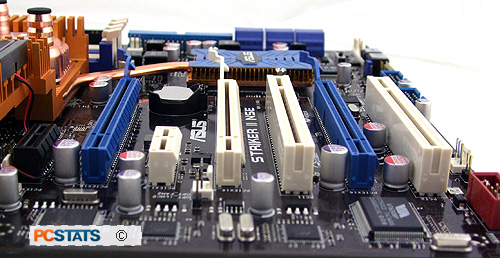The ASUS Striker II
NSE motherboard has a lot of components and features to pack into
a standard-sized ATX layout, but it manages to keep most of its PCB clean and tidy. Most
notable about the board's physical layout is the placement of three PCI Express x16 slots,
which allow the motherboard to run videocards in three-way SLI.

Now, not
every NVIDIA videocard will be able to run in three-way SLI, since only cards with doubled SLI
connectors can be linked together. Currently this limits three-way SLI to the Geforce 8800GTX and
Ultra, the 9800GTX, and Geforce GTX 260, 280 and 285.
These videocards are all take up
at least two expansion slots for cooling, and when three of them are installed
on the ASUS Striker II NSE, they'll leave only a single PCI
Express slot available (which is dedicated to the bundled SupremeFX II discrete audio card). Other killer gaming gear
might have to sit out if you go three-way, and you should have massive cooling and
airflow for whatever case three high-end videocards are going into.

Fortunately with one PCI Express x16 videocard or a vanilla two-way SLI set up you'll
have more space and expansion slots to work with than you need. Regardless of
how many videocards you decide to build your killer gaming rig with, setting up
and installing the Striker II NSE is easy. The motherboard has a lot of features, but
is designed to make them easily accessible and understandable.

ASUS has designed the Striker II NSE
motherboard so that it can be easily powered on and controlled without being mounted inside
a case. The system has dedicated power, reset and clear CMOS buttons, which make
it easy to tweak the system and try out components without re-mounting it in
a case, a must for overclockers.
ASUS has also thrown in a set of adhesive rubber feet (called the DIY
Pedestal) to raise the board off of flat surfaces, which increases airflow and also
provides some insulation from static shocks.

ASUS Q-connectors are little plastic blocks for the front-panel connectors of a case,
instead of hooking up each wire to the motherboard you plug everthing
in here first, then connect the entire block to the Striker II NSE motherboard when
it's installed inside a case.
Of course, that's not all ASUS has included with the Striker II
NSE motherboard. There's an entire box full of them waiting for you on the next
page...
